 |
Recap: What Is Section 8(e)?
TSCA Section 8(e) is a single short paragraph that has been the source of widespread confusion since TSCA became law in 1976. Section 8(e) simply states that U.S. chemical manufacturers (including importers), processors, and distributors must notify the EPA within 30 days of obtaining information that reasonably supports the conclusion that their chemical products present a substantial risk of injury to the health or environment.
Reporting is not required if the company has actual knowledge that the EPA has already been informed of such information. Many of the misunderstandings regarding Section 8(e) relate to the meaning of substantial risk and actual knowledge. Those misunderstandings have sometimes caused regulated entities to either not report when they should have or report when they did not need to.
In last month’s article, we reviewed the meaning of substantial risk and exposure and scenarios for reporting spills under Section 8(e). This article will review reporting wastewater discharges under the National Pollutant Discharge Elimination System (NPDES) permit program and Section 8(e) reporting for emergency incidents under the underground storage tank (UST) program.
Join us for the Nanoscale Materials webinar on August 5 to learn regulatory compliance considerations for commercializing nanomaterials and nanomaterial enabled products. Register now!
What about Wastewater Discharges?
Significant toxicity information developed by a company as required by its NPDES permit is presumed by the EPA to be reported to the state authority or, in some states, to the EPA itself. Therefore, such information is “known” by the EPA and is not Section 8(e) reportable. However, the permittee should consider the need to file a Section 8(e) report if additional information on facility wastewater discharges, such as unexpected persistence, bioaccumulation, or widespread contamination, which were not considered in setting the Clean Water Act (CWA) permit, becomes available.
Nanoscale Materials: Emerging Environmental, Safety and Health Compliance Concerns
After eight years of deliberation, the EPA recently proposed the first regulation aimed directly at the uncertain environmental, health and safety aspects of “nanoscale materials” as a broad class. Learn more.
USTs and Section 8(e)
Similarly, information reported to states that are authorized by the EPA to run the federal UST program is considered known to the EPA and need not be reported under Section 8(e). However, that information must be reported to states according to specified time frames—90 days for nonemergency contamination situations; immediately for emergency incidents of environmental contamination; and within 30 days for other substantial risk information. If those time frames are not met, Section 8(e) reporting may be required.

Very nice post. I just stumbled upon your weblog and wanted to mention that I’ve truly loved browsing your weblog posts. After all I’ll be subscribing to your feed and I’m hoping you write once more very soon!